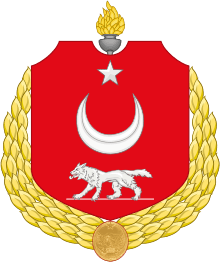Asena
Asena is the name of a she-wolf associated with the Oghuz Turkic foundation myth.[1][2] The ancestress of the Göktürks is also a she-wolf, mentioned yet unnamed in two different "Wolf Tales" recorded by Chinese chroniclers[3]

Legend
The legend of Asena tells of a young boy who survived a battle; a female wolf finds the injured child and nurses him back to health. The she-wolf, impregnated by the boy, escapes her enemies by crossing the Western Sea to a cave near the Qocho mountains and a city of the Tocharians, giving birth to ten half-wolf, half-human boys. Of these, Ashina becomes their leader and establishes the Ashina clan, which ruled over the Göktürk and other Turkic nomadic empires.[4][5]
However, Chinese sources stated that the Göktürks' precursors were simply "mixed barbarians" (雜胡) who migrated from Pingliang to the Altai region,[6][7] where they would become known as expert blacksmiths, akin to the Scythians.[8]
Modern era
With the rise of Turkish ethnic nationalism in the 1930s, the veneration of figures of Turkic Mythology, such as Bozkurt, Asena and Ergenekon was resurgent.[9] The symbol of Asena is embossed on the stage of the personal theater of the first President of Turkey, Mustafa Kemal Atatürk, at his residence in Ankara.[9] He also referenced the motif in his speeches, such as that of 13 February 1931 in Malatya titled Türk Ocağı.[10][11]
See also
- She-wolf (Roman mythology), a similar figure in the mythical foundation of Rome
- Romulus and Remus
References
- André Wink. Al-Hind: The Making of the Indo-Islamic World. Brill Academic Publishers, 2002. ISBN 0-391-04173-8. Page 65.
- Ziya Gökalp, transcription: Şahin Filiz, "Türk devletinin tekâmülü 12: Hakanlık Teşkilatı",Küçük Mecmua -II-, Bu da Çinlilere göre (Asena=Kurt) manasındadır (in Turkish)
- Golden, Peter B. (August 2018). "The Ethnogonic Tales of the Türks" in The Medieval History Journal, 21(2). 21 (2): 291–327
- Findley, Carter Vaughin. The Turks in World History. Oxford University Press, 2005. ISBN 0-19-517726-6. Page 38.
- Roxburgh, D. J. (ed.) Turks, A Journey of a Thousand Years. Royal Academy of Arts, London, 2005. Page 20.
- Wei Zheng et al., Book of Sui, Vol. 84. (in Chinese)
- Sima Guang, Zizhi Tongjian, Vol. 159. (in Chinese)
- Christopher I. Beckwith, Empires of the Silk Road: A History of Central Eurasia from the Bronze Age to the Present, Princeton University Press, 2011, p.9
- Murat Arman, "The Sources of Banality In Transforming Turkish Nationalism", CEU Political Science Journal, issue: 2 (2007), p. 136.
- Atatürk'ün Söylev ve Demeçleri II, Atatürk Kültür, Dil ve Tarih Yüksek Kurumu Atatürk Araştırma Merkezi, 1989, p. 301, Turkish text: Demiryollarını kullanacak olan Türk milleti menşeindeki ilk sanatkarlığına, demirciliğinin eserini tekrar göstermiş olmakla müftehir olacaktır. (in Turkish)
- Mehmet Önder, Atatürk'ün Yurt Gezileri, Türkiye İş Bankası, 1975, p. 268.